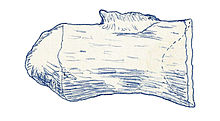Macrurosaurus
This article needs additional citations for verification. (July 2020) |
| Macrurosaurus Temporal range: late Albian,
| |
|---|---|

| |
| Vertebra | |
| Scientific classification | |
| Domain: | Eukaryota |
| Kingdom: | Animalia |
| Phylum: | Chordata |
| Clade: | Dinosauria |
| Clade: | Saurischia |
| Clade: | †Sauropodomorpha |
| Clade: | †Sauropoda |
| Clade: | †Macronaria |
| Clade: | †Titanosauriformes |
| Genus: | †Macrurosaurus Seeley, 1869 |
| Type species | |
| †Macrurosaurus semnus Seeley, 1869
| |
Macrurosaurus (meaning "large-tailed lizard") is the name given to a genus of dinosaur from the Early Cretaceous. It was a titanosauriform which lived in what is now Europe.
The genus Macrurosaurus was named by Harry Govier Seeley in 1869 in his index of fossils from the Cambridge Greensand.[1] In 1876 Seeley more thoroughly described the type species, Macrurosaurus semnus, making the name valid.[2] No other species are known. The generic name is derived from Greek makros, "large", and oura, "tail". The specific name is derived from Greek semnos, "stately" or "impressive".
The holotype of Macrurosaurus, SM B55630, consists of two series of caudal vertebrae found around 1864 near Cambridge, England in the Cambridge Greensand, strata themselves deposited during the Cenomanian but containing reworked fossil material dating perhaps from around the late Albian.[3] The first was acquired by the Woodwardian Museum from William Farren who had it dug up at Coldhams Common near Barnwell. This series is made up of 25 proximal vertebrae. The second was found by Reverend W. Stokes-Shaw at a slightly more western location near Barton. It contained fifteen smaller distal vertebrae, from the tail end. Seeley, acting on the presumption that both finds belonged to the same species if not individual, combined the two series into one tail of about 4.5 metres length.
Other fragmentary fossils from England (Acanthopholis platypus), France and Argentina have later been referred to Macrurosaurus but the identity is today doubted.
Macrurosaurus was by Seeley himself estimated to be about ten metres long. Often a length of around twelve metres (40 ft) is indicated in the popular literature. The vertebrae in front are procoelous, meaning that the vertebral centra are hollow at the front end and convex at the back. Those behind are amphicoelous: hollow at both ends. Seeley assumed that the full count of tail vertebrae would have been about fifty.
Macrurosaurus was by Seeley assigned to the Dinosauria. Richard Lydekker in 1888 understood it belonged to the Sauropoda. In 1929 Friedrich von Huene referred it to the Titanosauridae. In recent years however, it has been commonly concluded that the species cannot be further determined than a more general Titanosauriformes. Also it is today often seen as a nomen dubium.
Notes
- ^ Seeley, Harry Govier (1869). "Index to the fossil remains of Aves, Ornithosauria, and Reptilia, from the Secondary System of Strata, arranged in the Woodwardian Museum of the University of Cambridge". Annals and Magazine of Natural History. 5 (27): 1–143. doi:10.1080/00222937008696143. ISSN 0374-5481.
- ^ H.G. Seeley, 1876, "On Macrurosaurus semnus (Seeley), a long tailed animal with procoelous vertebrae from the Cambridge Upper Greensand, preserved in the Woodwardian Museum of the University of Cambridge", Quarterly Journal of the Geological Society of London 32: 440-444 doi:10.1144/GSL.JGS.1876.032.01-04.50
- ^ Unwin, D.M. (2003). "On the phylogeny and evolutionary history of pterosaurs". In Buffetaut, Eric; Mazin Jean-Michel (eds.). Evolution and Palaeobiology of Pterosaurs. Geological Society Special Publication 217. London: Geological Society. pp. 139–190. ISBN 1-86239-143-2.












